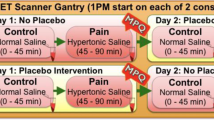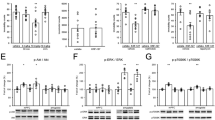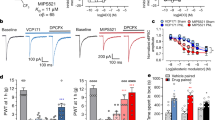Abstract
The cellular events involved in muscarinic analgesia were investigated in the mouse hot-plate test. Intracerebroventricular (i.c.v.) pretreatment with antisense oligonucleotides (aODNs) against the α subunit of Gq and G11 proteins prevented the analgesia induced by physostigmine and oxotremorine. Furthermore, administration of the phospholipase C (PLC) inhibitor U-73122, as well as the injection of an aODN complementary to the sequence of PLCβ1, antagonized the increase of the pain threshold induced by both cholinomimetic drugs. In mice undergoing treatment with LiCl, which impairs phosphatidylinositol synthesis, or treatment with heparin, an IP3 receptor antagonist, the antinociception induced by physostigmine and oxotremorine was dose-dependently antagonized. I.c.v. pretreatment with TMB-8, a blocker of Ca2+ release from intracellular stores, prevented the increase of pain threshold induced by the investigated cholinomimetic drugs. Coadministration of Ca2+ restored the muscarinic analgesia in LiCl, heparin, and TMB-8-preatreated mice. On the other hand, i.c.v. pretreatment with the selective protein kinase C (PKC) inhibitor calphostin C, resulted in a dose-dependent enhancement of physostigmine- and oxotremorine-induced antinociception. The administration of PKC activators, such as PMA and PDBu, dose dependently prevented the cholinomimetic drug-induced increase of pain threshold. Neither aODNs nor pharmacological treatments employed produced any behavioral impairment of mice as revealed by the rota-rod and hole-board tests. These results indicate a role for the PLC-IP3 pathway in central muscarinic analgesia in mice. Furthermore, activation of PKC by cholinomimetic drugs may represent a pathway of negative modulation of muscarinic antinociception.
Similar content being viewed by others
Log in or create a free account to read this content
Gain free access to this article, as well as selected content from this journal and more on nature.com
or
References
Ashkenazi A, Winslow JW, Peralta EG, Peterson GL, Schimerlik MI, Capon DJ et al (1987). An m2 muscarinic receptor subtype coupled to both adenylyl cyclase and phosphoinositide turnover. Science 238: 672–675.
Bartolini A, Ghelardini C, Fantetti L, Malcangio M, Malmberg-Aiello P, Giotti A (1992). Role of muscarinic receptor subtypes in central antinociception. Br J Pharmacol 105: 77–82.
Caulfield MP (1993). Muscarinic receptors—characterization, coupling and function. Pharmacol Ther 58: 319–379.
Caulfield MP, Birdsall NJM (1998). International Union of Pharmacology. XVII. Classification of muscarinic acetylcholine receptors. Pharmacol Rev 50: 279–290.
Felder CC (1995). Muscarinic acetylcholine receptors: signal transduction through multiple effectors. FASEB J 9: 619–625.
Ferris CD, Cameron AM, Huganir RL, Snyder SH (1992). Quantal calcium release by purified reconstituted inositol 1,4,5-trisphosphate receptors. Nature 35: 350–352.
Ghelardini C, Galeotti N, Bartolini A (2000). Loss of muscarinic antinociception by antisense inhibition of M1 receptors. Br J Pharmacol 129: 1633–1640.
Ghelardini C, Galeotti N, Gualtieri F, Romanelli MN, Bartolini A (1996). S-(−)-ET126: a potent and selective M1 antagonist in vivo and in vitro. Life Sci 58: 991–1000.
Gillbert PG, Gordh Jr T, Hartvig P, Jansson I, Petterson J, Post C (1989). Characterization of the antinociception induced by intrathecally administered carbachol. Pharmacol Toxicol 64: 340–343.
Gomeza J, Zhang L, Kostenis E, Felder CC, Bymaster FP, Brodkin J et al (2001). Generation and pharmacological analysis of M2 and M4 muscarinic receptor knockout mice. Life Sci 68: 2457–2466.
Haley TJ, Mccormick WG (1957). Pharmacological effects produced by intracerebral injection of drugs in the conscious mouse. Br J Pharmacol Chemother 12: 12–15.
Hartvig P, Gillberg PG, Gordh T, Post C (1989). Cholinergic mechanisms in pain and analgesia. Trends Pharmacol Sci 1(Suppl.): 75–79.
Iwamoto ET, Marion L (1993). Characterization of the antinociception produced by intrathecally administered muscarinic agonists in rats. J Pharmacol Exp Ther 266: 329–338.
Jonas S, Sugimori M, Llinas R (1997). Low molecular weight heparin a neuroprotectant? Ann NY Acad Sci 825: 389–393.
Kennedy ED, Xhalliss RA, Rangan CI, Nahorski SR (1990). Reduced inositol polyphosphate accumulation and inositol supply induced by lithium in stimulated cerebral cortex slices. Biochem J 267: 781–786.
Kobayashi E, Nakano H, Morimoto M, Tamaoki T (1989). Calphostin C (UCN-1028C), a novel microbial compound, is a highly potent and specific inhibitor of protein kinase C. Biochem Biophys Res Commun 159: 548–553.
Kores B, Lader MH (1997). Irreversible lithium neurotoxicity: an overview. Clin Neuropharmacol 20: 283–299.
Malagodi MH, Chiou CY (1974). Pharmacological evaluation of a new Ca++ antagonist, 8-(N,N-diethylamino)-octyl-3,4,5-trimethoxybenzoate hydrochloride (TMB-8): studied in smooth muscle. Eur J Pharmacol 27: 25–33.
Mignery GA, Sudhof TC (1990). The ligand binding sites and transduction mechanism in the inositol-1,4,5-triphosphate receptor. EMBO J 9: 3893–3898.
Naguib M, Yaksh TL (1997). Characterization of muscarinic receptor subtypes that mediate antinociception in the rat spinal cord. Anesth Analg 85: 847–853.
Nishizuka Y (1992). Intracellular signaling by hydrolysis of phospholipids and activation of protein kinase C. Science 258: 607–614.
O'Callaghan JP, Holtzman SG (1975). Quantification of the analgesic activity of narcotic antagonists by a modified hot-plate procedure. J Pharmacol Exp Ther 192: 497–505.
Pellandra CL (1933). La geneserine-morphine adjuvant de l'anesthesia generale. Lyon Med 151: 653.
Phiel CJ, Klein PS (2001). Molecular targets of lithium action. Annu Rev Pharmacol Toxicol 41: 789–813.
Rebecchi MJ, Pentyala SN (2000). Structure, function and control of phosphoinositide-specific phospholipase C. Physiol Rev 80: 1291–1335.
Sanchez-Blazquez P, Garzon J (1998). Delta opioid subtypes activates inositol-signaling pathways in the production of antinociception. J Pharmacol Exp Ther 285: 820–827.
Smith SE, Meldrum BS (1992). The protein kinase C activators, phorbol 12-myrystate,13-acetate and phorbol 12,13-dibutyrate, are convulsant in the pico-nanomolar range in mice. Eur J Pharmacol 213: 133–135.
Taylor SJ, Chae HZ, Rhee SG, Exton JH (1991). Activation of β1 isozyme of phospholipase C by α subunits of the Gq class of G protein. Nature 350: 516–518.
Vaught J, Pelley K, Costa LG, Sether P, Enna SJ (1985). A comparison of the antinociceptive responses to GABA-receptor agonists THIP and baclofen. Neuropharmacology 24: 211–216.
Vocci FJ, Welch SP, Dewey WL (1980). Differential effects of divalent cations, cation chelators and ionophore (A23187) on morphine and dibutyryl guanosine 3′:5′-cyclic monophosphate antinociception. J Pharmacol Exp Ther 214: 463–466.
Wakdo GL, Northup J, Perkins JP, Harden TK (1983). Characterization of an altered membrane form of the beta-adrenergic receptor produced during agonist-induced desensitization. J Biol Chem 258: 13900–13908.
Yule DI, Williams JA (1992). U73122 inhibits Ca2+ oscillations in response to cholecystokinin and carbachol but not to JMV-180 in rat pancreatic acinar cells. J Biol Chem 267: 13830–13835.
Acknowledgements
This work was supported by grants from MIUR.
Author information
Authors and Affiliations
Corresponding author
Rights and permissions
About this article
Cite this article
Galeotti, N., Bartolini, A. & Ghelardini, C. The Phospholipase C-IP3 Pathway is Involved in Muscarinic Antinociception. Neuropsychopharmacol 28, 888–897 (2003). https://doi.org/10.1038/sj.npp.1300111
Received:
Revised:
Accepted:
Published:
Issue date:
DOI: https://doi.org/10.1038/sj.npp.1300111
Keywords
This article is cited by
-
Inhibition of the PKCγ-ε Pathway Relieves from Meningeal Nociception in an Animal Model: An Innovative Perspective for Migraine Therapy?
Neurotherapeutics (2013)
-
Reversal of NO-induced nociceptive hypersensitivity by St. John’s wort and hypericin: NF-κB, CREB and STAT1 as molecular targets
Psychopharmacology (2013)
-
Antidepressant-like effect of artemin in mice: a mechanism for acetyl-l-carnitine activity on depression
Psychopharmacology (2011)



